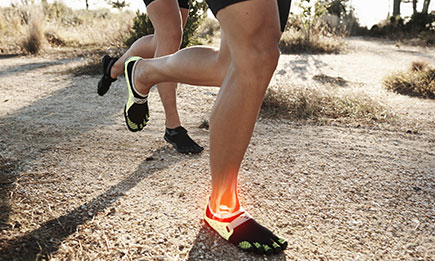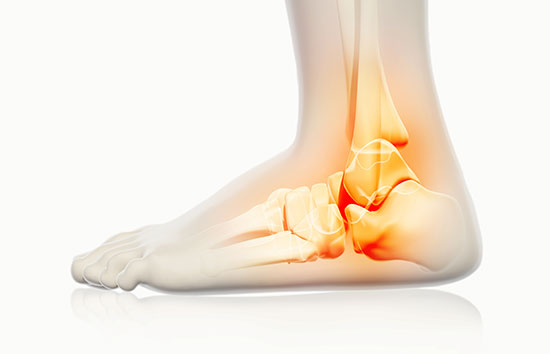

About 1% of the adult population suffers from painful arthrosis of the upper ankle joint.
Unlike arthritis of the knee or hip, it often affects younger patients. Chronic instability in the ankle leads to arthritis in the long run, and as this often results from sports injuries, we will see an increase in cases of ankle arthritis over the coming decades, a trend boosted by generally prolonged life expectancy.
Patients can recognize ankle arthritis based on restrictions to mobility, such as joint stress, swelling, and pain. Common symptoms include:
The treatment of ankle arthritis requires knowledge of the underlying causes to consider and eliminate those during therapy.
Ankle fracture
One possible cause for ankle arthritis is a bone fracture in the ankle joint, which can result in malposition and permanent cartilage damage. Malposition of the calf bone leads to a minor parietal shift in the ankle joint and as a consequence causes arthritis. Despite trauma surgery, this can change the joint structure in the long run.
Malposition
Congenital or acquired malposition of the leg leads to permanent overload on the ankle joint, causing osteoarthritis. It can also result from a fractured bone close to the ankle joint which did not heal correctly. Malposition of the foot (such as flatfoot or clubfoot) also increases pressure on the joint, causing osteoarthritis.
Ligament injuries
Damage of the ligaments in the ankle joint, as caused by twisting or spraining the ankle, may also lead to permanent instability and arthritis.
Cartilage lesions
Damage to the smooth cartilage surface is often caused by injuries from accidents, but also overload and internal disorders of the (joint) metabolism.
Rheumatism
Rheumatism (Chronic Polyarthritis) destroys the synovial membrane and damages cartilage, thereby tearing the joint. Rheumatism in the capsular ligament structure and tendons additionally causes malposition of the foot and instability, accelerating the destruction of the joint.
Other inflammatory joint disorders
These disorders, commonly known as rheumatic diseases, cause cartilage damage and are similar to rheumatoid arthritis.
Metabolic disorders
Metabolic disorders indicate that diet can, directly or indirectly, negatively influence cartilage, as observed when residues alter joint mechanics.
Infection
Bacterial infections can cause damage to the synovial membrane and cartilage, leading to rapid joint destruction.

Every treatment starts with a detailed analysis to consider or eliminate possible causes over the course of the therapy.
Treatment can be either joint-preserving or joint-replacing. The choice of treatment depends on the degree of severity of the arthritis.
Several optional treatments are possible during the early and middle stages of ankle arthritis.
Treatments during stage 1/2
Treatments during stage 3
In the final stage of ankle arthrosis (stage 4), it is possible to choose between the insertion of an artificial joint (endoprosthesis) or a stiffening of the joint facets. The choice of treatment follows thorough clinical examination an x-ray diagnostic with consideration for the soft part ratio (scar tissue, perfusion) and the destruction of osseous structures in the ankle joint.
When surgery is required, a suitable method is researched, discussed, and implemented. A fusion procedure of the ankle joint is rarely necessary. The decision can only be made once a medical examination and diagnosis have taken place.

In cases where the upper ankle joint is also compromised, we usually recommend the targeted use of an ankle replacement rather than complete stiffening, thus avoiding overload of the adjacent joints and enabling a mostly natural motion sequence.
Having conducted over 1,200 ankle endoprosthesis implants, Dr. Boack is one of the most experienced surgeons worldwide in this field.
We are the only clinic worldwide offering minimal-invasive TAR implementation by so-called keyhole-surgery. Get in contact with us today for further information and to book your examination and consultation appointment.
Our service team is looking forward to consulting with you personally and individually. You can reach us via telephone or contact form.
